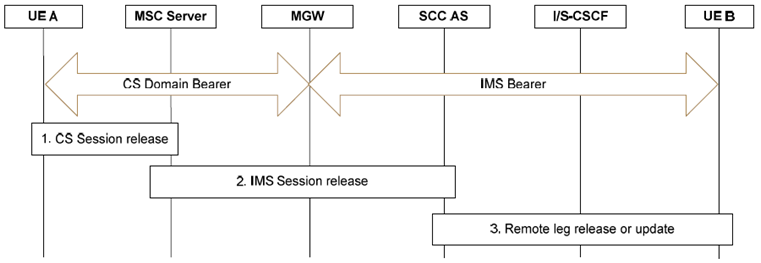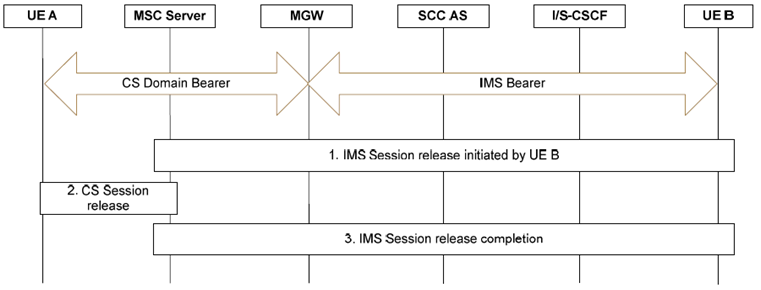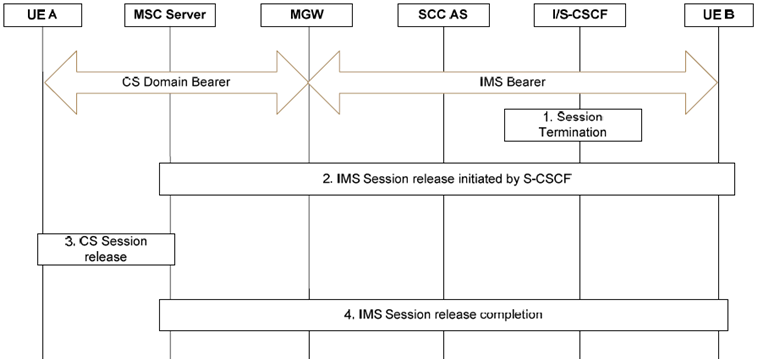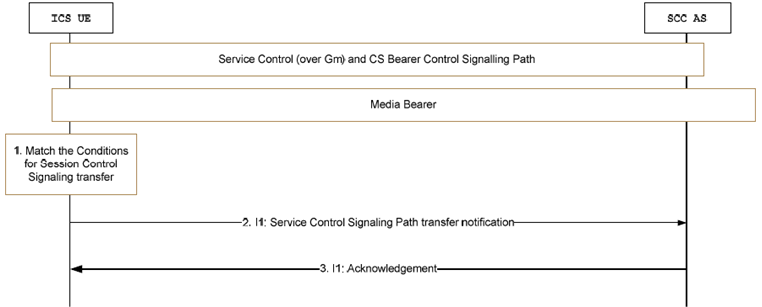Content for TS 23.292 Word version: 18.0.0
1…
4…
5…
7…
7.2…
7.3…
7.3.2.2…
7.3.2.2.4…
7.4…
7.4.2.2…
7.4.2.2.3…
7.4.2.2.7…
7.5…
7.6…
7.6.1.2.2.6…
7.6.1.2.3…
7.6.1.2.3.5…
7.6.1.2.3.6…
7.6.2…
7.6.2.7
7.6.2.8…
7.6.2.11…
7.6.3…
7.7…
7.7.2…
7.9…
7.9.2…
7.9.2.4
7.9.2.5
8…
A…
G…
H…
H.5…
H.5.3…
7.7.2 Session Release for MSC Server enhanced for ICS
7.7.2.1 General
7.7.2.2 Session Release by served UE
7.7.2.3 Session Release by far-end
7.7.2.4 Network initiated Session Release
7.8 Loss of Gm capability
...
...
7.7.2 Session Release for MSC Server enhanced for ICS p. 103
7.7.2.1 General p. 103
If receiving a CS session release from the non ICS UE the MSC Server enhanced for ICS shall release the session towards IMS. The SCC AS shall further update the remote leg, to reflect the change of media. If receiving a session release from the IMS, the MSC Server enhanced for ICS shall release the CS session with the UE.
7.7.2.2 Session Release by served UE p. 103
Figure 7.7.2.2-1 provides a call flow illustrating the session release procedures initiated by an UE attached to an MSC Server enhanced for ICS.

Figure 7.7.2.2-1: Session Release initiated by UE A when using an MSC server enhanced for ICS
(⇒ copy of original 3GPP image)
(⇒ copy of original 3GPP image)
7.7.2.3 Session Release by far-end p. 104
Figure 7.7.2.3-1 provides a call flow illustrating the session release procedures initiated by far end for an UE attached to an MSC Server enhanced for ICS.

Figure 7.7.2.3-1: Session Release initiated by far end when using an MSC server enhanced for ICS
(⇒ copy of original 3GPP image)
(⇒ copy of original 3GPP image)
7.7.2.4 Network initiated Session Release p. 104
Figure 7.7.2.4-1 provides a call flow illustrating the session release procedures initiated by the home IMS network for an UE attached to an MSC Server enhanced for ICS.

Figure 7.7.2.4-1: Network initiated Session Release when using an MSC server enhanced for ICS
(⇒ copy of original 3GPP image)
(⇒ copy of original 3GPP image)
Step 1.
The S-CSCF decides the session should be terminated due to administrative reasons or due to service expiration.
Step 2.
The S-CSCF initiates a session release towards UE B and MSC server.
Step 3.
The MSC Server releases CS session with UE A.
Step 4.
Completion of session release is provided from UE B and MSC Server to S-CSCF. Step 4 does not have to wait for step 3 to complete.
7.8 Loss of Gm capability |R9| p. 105
The Figure 7.8-1 provides an example flow for transfer of Service Control Signalling Path from Gm to I1 when the UE discovers Gm is not available and UE supports I1.

Figure 7.8-1: Service Control Signalling Path handover from Gm to I1
(⇒ copy of original 3GPP image)
(⇒ copy of original 3GPP image)
Step 1.
Upon detecting that there is a loss of Gm reference point, the ICS UE prepares to trigger the service control signalling path transfer.
Step 2.
ICS UE sends the service control signalling path transfer notification to the SCC AS over I1 requesting a switch to I1 for Service Control Signalling Path.
Step 3.
SCC AS accepts the transfer request, and returns the acknowledgement to ICS UE over I1.
After the above steps, the Service Control Signalling Path is switched from the Gm reference point to the I1 reference point.